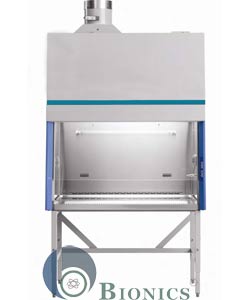How Much Do You Know About Class 2 Biosafety Cabinets?
Class 2 Biosafety Cabinets – Vital for Lab Safety and Biological Containment

Modern laboratories prioritise safety for workers, materials, and environments. Whether it's handling live pathogens or sensitive diagnostics, biosafety cabinets play an integral role in contamination prevention and sample integrity.
Among the available options, Class 2 Biosafety Cabinets stand out for their balanced protection. These units are crucial for working with moderate-risk organisms and sensitive samples.
Overview of Biosafety Cabinets in Laboratory Environments
Biosafety cabinets are specially designed, enclosed systems that ventilate and filter lab air. They use advanced filters to trap harmful particles before air re-enters the lab.
These units are generally classified into three categories—Class I, Class II, and Class III. Among these, Class 2 biosafety cabinets are the standard choice for most applications.
Why Class II Cabinets Are the Preferred Choice in Labs
Class 2 Biosafety Cabinets are designed to safeguard three aspects: the operator, the sample, and the environment. They utilise downward laminar airflow within a sealed system.
Contaminated air is drawn into the cabinet and filtered through HEPA systems before recirculation or exhaust. These cabinets are frequently used in labs handling infectious agents or clinical samples.
Essential Features of Class 2 Safety Cabinets
A Class 2 microbiological safety cabinet includes several advanced features such as:
• Medical-grade filters for capturing contaminants
• Uniform downward airflow to protect the sample zone
• Pressure differentials that maintain internal containment
• Built-in UV sterilisation for decontaminating surfaces
• Noise-reducing construction for better working conditions
• Clear front panel for visibility and safety
These elements support lab workers in maintaining sterile working environments.
Applications in Research and Healthcare
Class 2 Biosafety Cabinets are widely deployed in clinical labs, vaccine R&D, and academic research. They are ideal for safe handling of samples during testing and experimentation.
Whether in hospitals or drug manufacturing, these units are essential for clean procedures.
Advantages of Installing Class 2 Cabinets in Your Lab
Using Class 2 cabinets offers significant improvements in contamination control and user safety:
• Prevents contamination during sensitive procedures
• Shields operators from harmful aerosols and pathogens
• Ensures filtered air is safe for release or recirculation
These cabinets help labs meet safety regulations while maintaining workflow.
Design and Compliance Standards
Top manufacturers design units compliant with Class 2 Biosafety Cabinets major biosafety regulations worldwide. Class 2 units are sub-classified as A1, A2, B1, and B2—each with distinct airflow and exhaust features.
• Type A2: Recirculates 70% and exhausts 30% of filtered air
• Type B2: Used for hazardous vapors and chemicals
Matching the cabinet type to your process is essential.
Choosing the Right Biosafety Cabinet
Before purchasing, consider:
• Your application type (e.g., diagnostics, pharma, research)
• Available lab space and utility infrastructure
• Energy consumption and maintenance frequency
• Manufacturer reputation and post-sale support
Consulting with experts ensures the cabinet fits both budget and compliance goals.
Best Practices for Using Class II Biosafety Cabinets
For optimal results:
• Avoid placing near doors, vents, or fans
• Ensure annual certification and airflow testing
• Ensure operators follow best practices
Operational best practices include:
• Use gloves, gowns, and face shields while operating
• Avoid sudden or quick arm movements
• Clean all contact points post-operation
• Use UV lights only when cabinet is off and unoccupied
Final Thoughts on Class 2 Biosafety Cabinets
Class 2 biosafety cabinets are essential for labs that value safety, precision, and cleanliness. They ensure contamination-free experiments and personnel safety.
From clinical research to vaccine development, Class II cabinets copyright the highest biosafety levels. When investing in a biosafety cabinet, prioritise compliance, usability, and long-term support—because lab safety is non-negotiable.